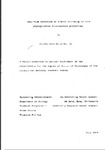REAL-TIME DETECTION OF FRONTS UTILISING IN VIVO PHYTOPLANKTON FLUORESCENCE PROPERTIES
| dc.contributor.author | HATTON, CERIDWEN SALLY | |
| dc.contributor.other | School of Biological and Marine Sciences | en_US |
| dc.date.accessioned | 2013-09-13T12:11:11Z | |
| dc.date.available | 2013-09-13T12:11:11Z | |
| dc.date.issued | 1987 | |
| dc.identifier | NOT AVAILABLE | en_US |
| dc.identifier.uri | http://hdl.handle.net/10026.1/1709 | |
| dc.description.abstract |
Historical data suggested that the monitoring of biological parameters might provide a real-time method of predicting the position of ocean fronts (critical to ASV operations). A series of oceanographic surveys was therefore undertaken to investigate the distribution of various parameters (including chlorophyll a (Chl a), nutrients, ATP, and pH) across such fronts. These surveys demonstrated that the continuous monitoring of chlorophyll fluorescence (Chl F) provided the most efficient real-time method for detecting the surface positions of deep-sea, shelf-sea, and shelf-edge fronts (often, in advance of temperature). The rate of change in a parameter (not absolute levels) proved to be critical in detecting a frontal system. | |
| dc.description.sponsorship | HM Naval Base, Portsmouth (Admiralty Research Establishment) | en_US |
| dc.language.iso | en | en_US |
| dc.publisher | University of Plymouth | en_US |
| dc.title | REAL-TIME DETECTION OF FRONTS UTILISING IN VIVO PHYTOPLANKTON FLUORESCENCE PROPERTIES | en_US |
| dc.type | Thesis | |
| plymouth.version | Full version | en_US |
| dc.identifier.doi | http://dx.doi.org/10.24382/3351 | |
| dc.identifier.doi | http://dx.doi.org/10.24382/3351 |
Files in this item
This item appears in the following Collection(s)
-
01 Research Theses Main Collection
Research Theses Main


